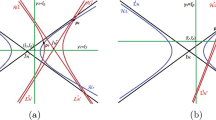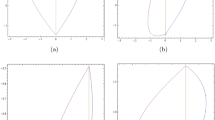Abstract
In this paper, we study a class of non-autonomous piecewise differential equations defined as follows: \(dx/dt=a_{0}(t)+\sum _{i=1}^{n}a_{i}(t)|x|^{i}\), where \(n\in \mathbb {N}^{+}\) and each \(a_{i}(t)\) is real, 1-periodic, and smooth function. We deal with two basic problems related to their limit cycles \(\big (\text {isolated solutions satisfying} x(0) = x(1)\big )\). First, we prove that, for any given \(n\in \mathbb {N}^{+}\), there is no upper bound on the number of limit cycles of such equations. Second, we demonstrate that if \(a_{1}(t),\ldots , a_{n}(t)\) do not change sign and have the same sign in the interval [0, 1], then the equation has at most two limit cycles. We provide a comprehensive analysis of all possible configurations of these limit cycles. In addition, we extend the result of at most two limit cycles to a broader class of general non-autonomous piecewise polynomial differential equations and offer a criterion for determining the uniqueness of the limit cycle within this class of equations.


Similar content being viewed by others
Availability of data and materials
No datasets were generated or analysed during the current study.
References
Andersen, K.M., Sandqvist, A.: Existence of closed solutions of an equation \({\dot{x}}=f (t, x)\), where \(f_{x}^{^{\prime }}(t, x)\) is weakly convex or concave in \(x\). J. Math. Anal. Appl. 229, 480–500 (1999). https://www.sciencedirect.com/science/article/pii/S0022247X98961716
Bravo, J.L., Fernández, M., Ojeda, I.: Hilbert number for a family of piecewise nonautonomous equations. Qual. Theory Dyn. Syst. 23, 119 (2024). https://doi.org/10.1007/s12346-023-00922-9
Bravo, J.L., Fernández, M., Tineo, A.: Periodic solutions of a periodic scalar piecewise ODE. Commun. Pure Appl. Anal. 6, 213–228 (2007). https://doi.org/10.3934/cpaa.2007.6.213
Calanchi, M., Ruf, B.: On the number of closed solutions for polynomial ODE’s and a special case of Hilbert’s 16th problem. Adv. Differ. Equ. 7, 197–216 (2002).https://projecteuclid.org/journals/advances-in-differential-equations/volume-7/issue-2/On-the-number-of-closed-solutions-for-polynomial-ODEs-and/ade/1356651851.short
Chamberland, M., Gasull, A.: Chini equations and isochronous centers in three-dimensional differential systems. Qual. Theory Dyn. Syst. 9, 29–38 (2010). https://doi.org/10.1007/s12346-010-0019-4
Coll, B., Gasull, A., Prohens, R.: Simple non-autonomous differential equations with many limit cycles. Commun. Appl. Nonlinear Anal. 15, 29–34 (2008)
Gasull, A., Libre, J.: Limit cycles for a class of Abel equations. SIAM J. Math. Anal. 21, 1235–1244 (1990). https://doi.org/10.1137/0521068
Gasull, A., Zhao, Y.: Existence of at most two limit cycles for some non-autonomous differential equations. Commun. Pure Appl. Anal. 22, 970–982 (2023). https://doi.org/10.3934/cpaa.2023016
Han, M., Hou, X., Sheng, L., Wang, C.: Theory of rotated equations and applications to a population model. Discrete Contin. Dyn. Syst. 38, 2171–2185 (2018). https://doi.org/10.3934/dcds.2018089
Ilyashenko, Y.: Hilbert-type numbers for Abel equations, growth and zeros of holomorphic functions. Nonlinearity 13, 1337–1342 (2000). https://doi.org/10.1088/0951-7715/13/4/319
Longo, I.P., Núñez, C., Obaya, R.: Critical transitions for scalar nonautonomous systems with concave nonlinearities: some rigorous estimates. Nonlinearity (2024).https://doi.org/10.1088/1361-6544/ad2eb9
Lloyd, N.G.: On a class of differential equations of Riccati type. J. Lond. Math. Soc. 10, 1–10 (1975). https://doi.org/10.1112/jlms/s2-10.1.1
Lloyd, N.G.: A note on the number of limit cycles in certain two-dimensional systems. J. Lond. Math. Soc. 20, 277–286 (1979). https://doi.org/10.1112/jlms/s2-20.2.277
Mawhin, J.: First order ordinary differential equations with several periodic solutions. Z. Angew. Math. Phys. 38, 257–265 (1987). https://doi.org/10.1007/BF00945410
Neto, A.L.: On the number of solutions of the equation \(\frac{{dx}}{{dt}} = \sum _{j = 0}^{n} a_{j}(t) x^{j}\), \(0 \le t \le 1\), for which \(x(0)=x(1)\). Inv. Math. 59, 67–76 (1980). https://doi.org/10.1007/BF01390315
Panov, A.A.: On the divariety of Poincaré mappings for cubic equations with variable coefficients. Funct. Anal. Appl. 33, 310–312 (1999). https://doi.org/10.1007/BF02467118
Panov, A.A.: The number of periodic solutions of polynomial differential equations. Math. Notes 64, 622–628 (1998). https://doi.org/10.1007/BF02316287
Pliss, V.A.: Nonlocal problems of the theory of oscillations. Academic Press (N.Y.) (1966). https://doi.org/10.1137/1013006
Sandqvist, A., Andersen, K.M.: On the number of closed solutions to an equation \({\dot{x}}= f(t, x)\), where \(f_{x^{n}}(t, x)\ge 0\)\((n= 1, 2,\text{ or } 3)\). J. Math. Anal. Appl. 159, 127–146 (1991)
Acknowledgements
This work is supported by the NSF of China (No. 12371183), and Guangdong Basic and Applied Basic Research Foundation (No. 2022A1515012105).
Author information
Authors and Affiliations
Contributions
All authors reviewed the manuscript.
Corresponding author
Ethics declarations
Conflict of interest
The authors declare no competing interests.
Additional information
Publisher's Note
Springer Nature remains neutral with regard to jurisdictional claims in published maps and institutional affiliations.
Rights and permissions
Springer Nature or its licensor (e.g. a society or other partner) holds exclusive rights to this article under a publishing agreement with the author(s) or other rightsholder(s); author self-archiving of the accepted manuscript version of this article is solely governed by the terms of such publishing agreement and applicable law.
About this article
Cite this article
Tian, R., Zhao, Y. The Limit Cycles for a Class of Non-autonomous Piecewise Differential Equations. Qual. Theory Dyn. Syst. 23, 185 (2024). https://doi.org/10.1007/s12346-024-01050-8
Received:
Accepted:
Published:
DOI: https://doi.org/10.1007/s12346-024-01050-8




